Risk Management Strategies for the Lewis Project: PROJ6003 Report
VerifiedAdded on 2022/10/18
|13
|2534
|19
Report
AI Summary
This report analyzes the risk management strategies employed by the Robert L. Frank Construction Company, focusing on the Lewis Project, a coal liquefaction pilot plant. It identifies various risks, categorized as external (political, economic, social, and weather), project (time, cost, work quality, construction, and technological), and internal (resource, project member, designer, contractor, subcontractor, supplier, and team). The report details risk identification methods, including brainstorming, interviews, and project understanding. It assesses risk probabilities, impacts, and rankings, providing a risk register. The conclusion emphasizes the importance of proactive risk management in the construction industry, highlighting the need for pre-emptive planning to address both general and project-specific risks such as subcontractor performance, material quality, and supply chain delays.
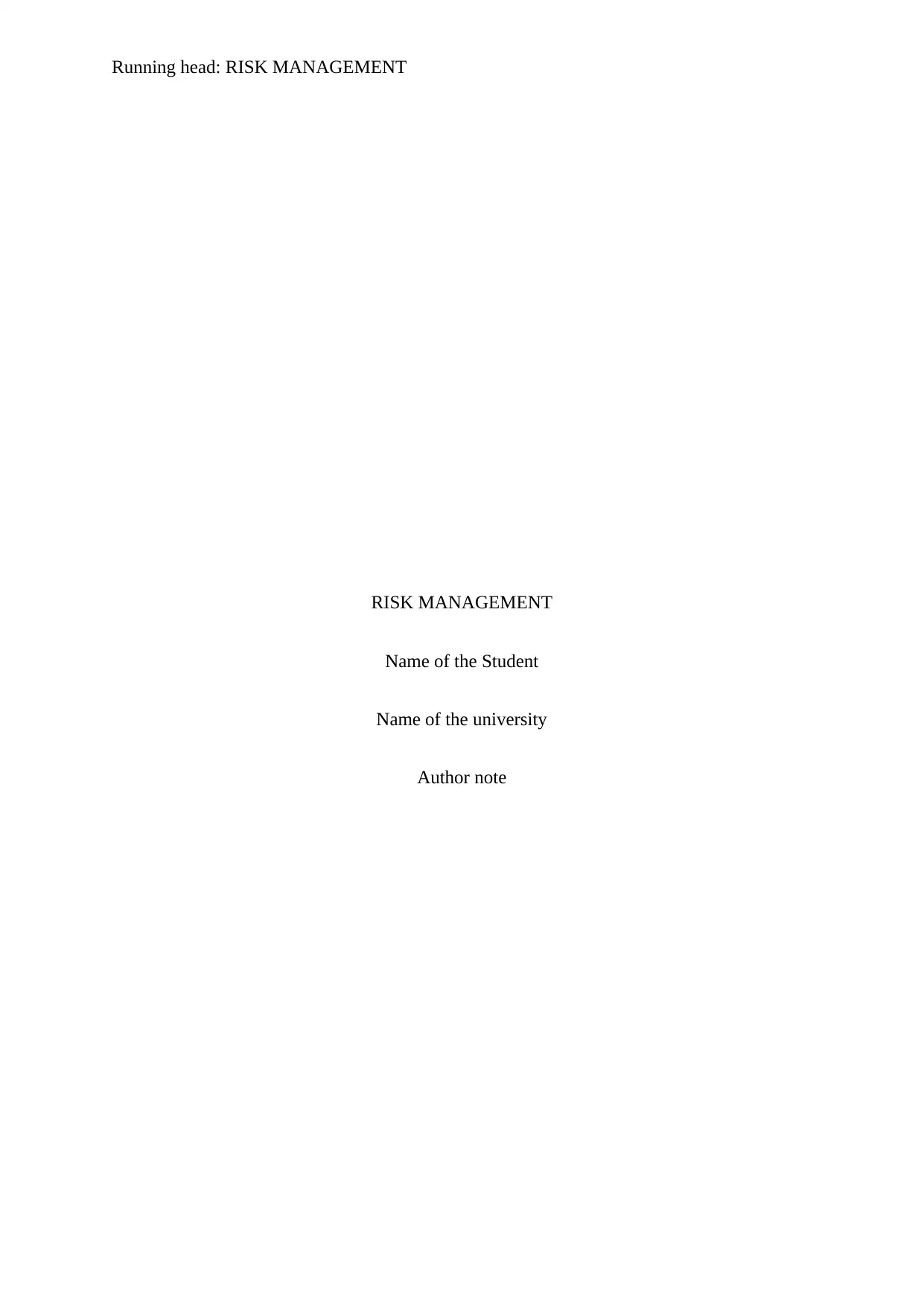
Running head: RISK MANAGEMENT
RISK MANAGEMENT
Name of the Student
Name of the university
Author note
RISK MANAGEMENT
Name of the Student
Name of the university
Author note
Paraphrase This Document
Need a fresh take? Get an instant paraphrase of this document with our AI Paraphraser
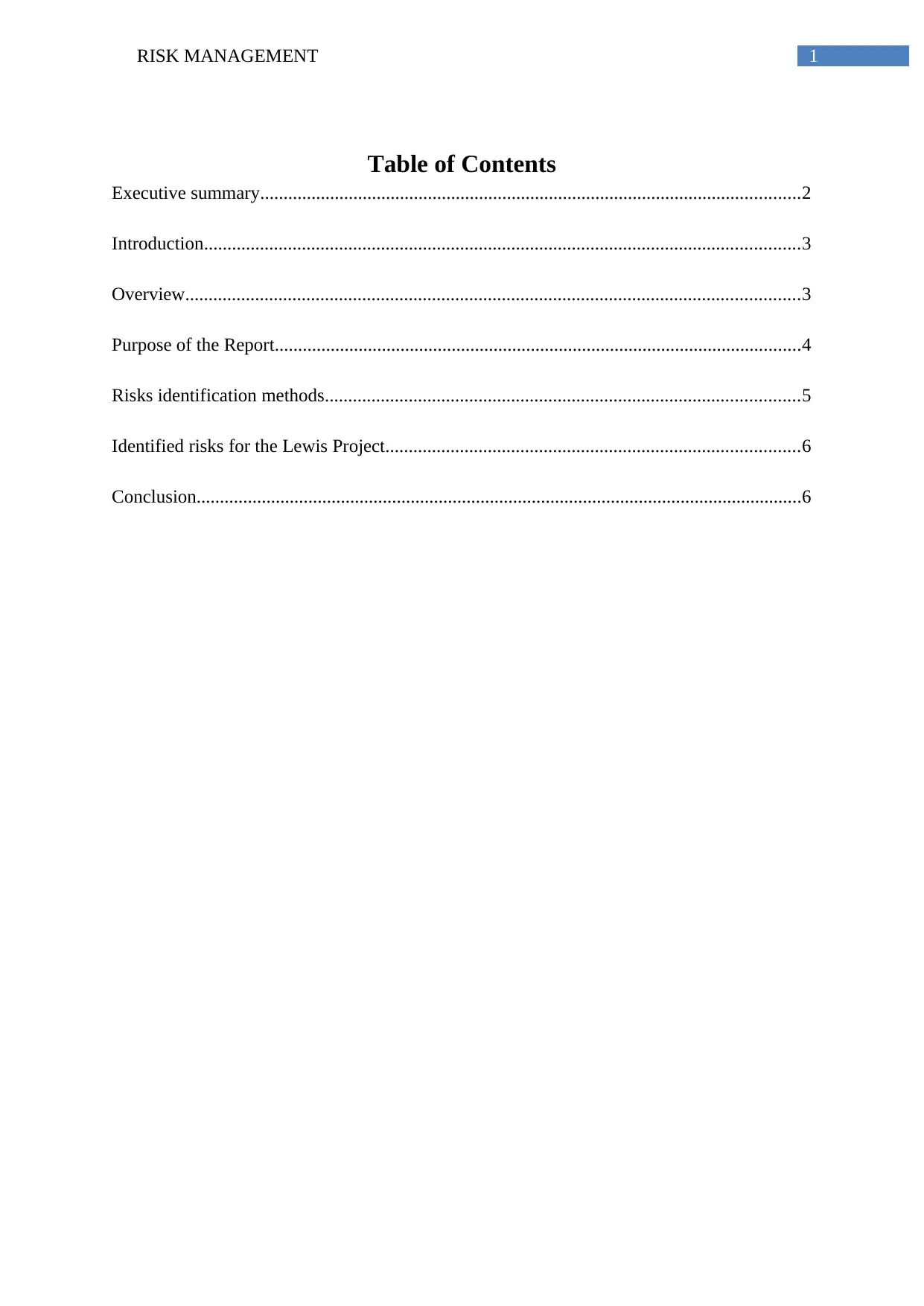
1RISK MANAGEMENT
Table of Contents
Executive summary....................................................................................................................2
Introduction................................................................................................................................3
Overview....................................................................................................................................3
Purpose of the Report.................................................................................................................4
Risks identification methods......................................................................................................5
Identified risks for the Lewis Project.........................................................................................6
Conclusion..................................................................................................................................6
Table of Contents
Executive summary....................................................................................................................2
Introduction................................................................................................................................3
Overview....................................................................................................................................3
Purpose of the Report.................................................................................................................4
Risks identification methods......................................................................................................5
Identified risks for the Lewis Project.........................................................................................6
Conclusion..................................................................................................................................6
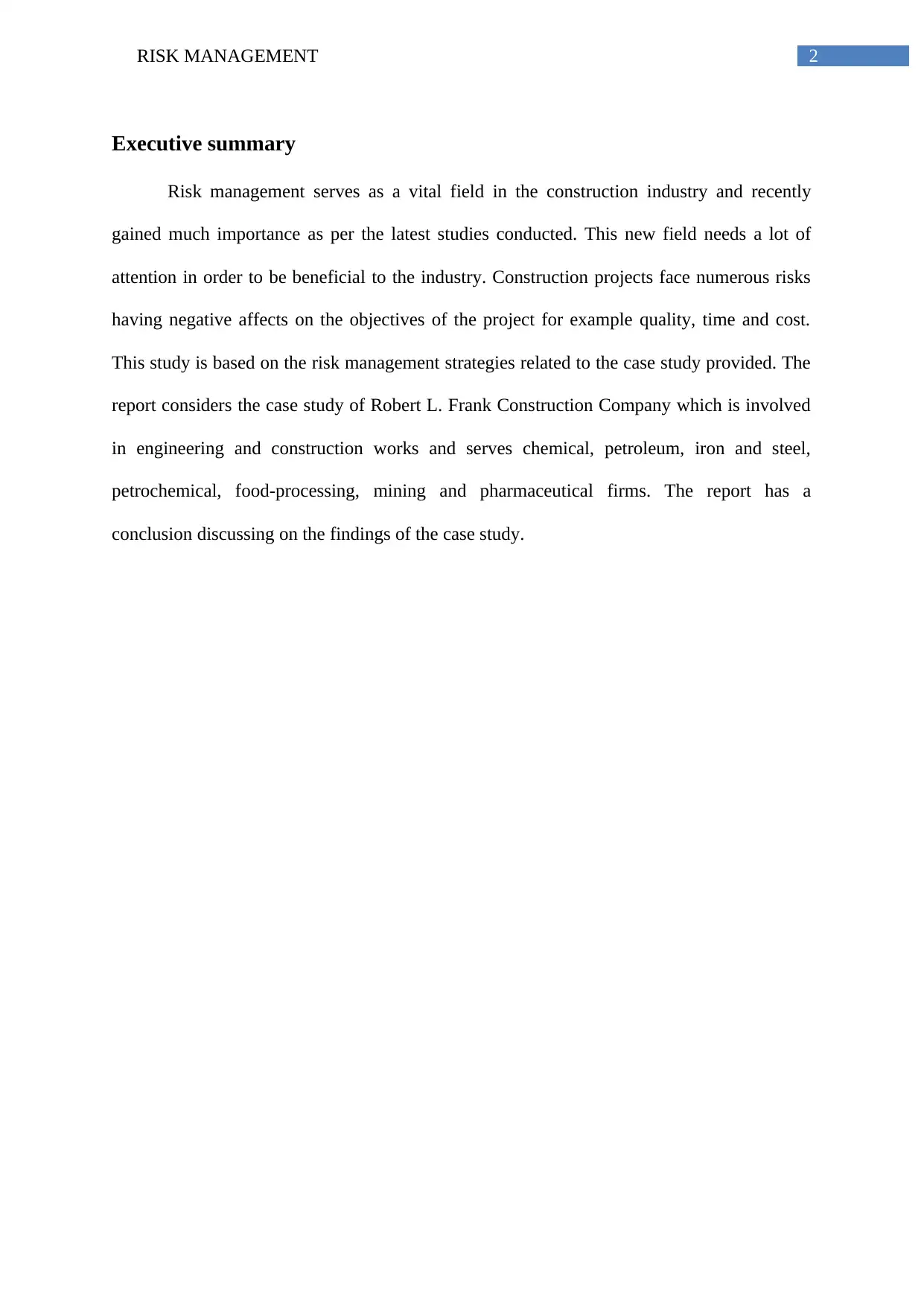
2RISK MANAGEMENT
Executive summary
Risk management serves as a vital field in the construction industry and recently
gained much importance as per the latest studies conducted. This new field needs a lot of
attention in order to be beneficial to the industry. Construction projects face numerous risks
having negative affects on the objectives of the project for example quality, time and cost.
This study is based on the risk management strategies related to the case study provided. The
report considers the case study of Robert L. Frank Construction Company which is involved
in engineering and construction works and serves chemical, petroleum, iron and steel,
petrochemical, food-processing, mining and pharmaceutical firms. The report has a
conclusion discussing on the findings of the case study.
Executive summary
Risk management serves as a vital field in the construction industry and recently
gained much importance as per the latest studies conducted. This new field needs a lot of
attention in order to be beneficial to the industry. Construction projects face numerous risks
having negative affects on the objectives of the project for example quality, time and cost.
This study is based on the risk management strategies related to the case study provided. The
report considers the case study of Robert L. Frank Construction Company which is involved
in engineering and construction works and serves chemical, petroleum, iron and steel,
petrochemical, food-processing, mining and pharmaceutical firms. The report has a
conclusion discussing on the findings of the case study.
⊘ This is a preview!⊘
Do you want full access?
Subscribe today to unlock all pages.

Trusted by 1+ million students worldwide
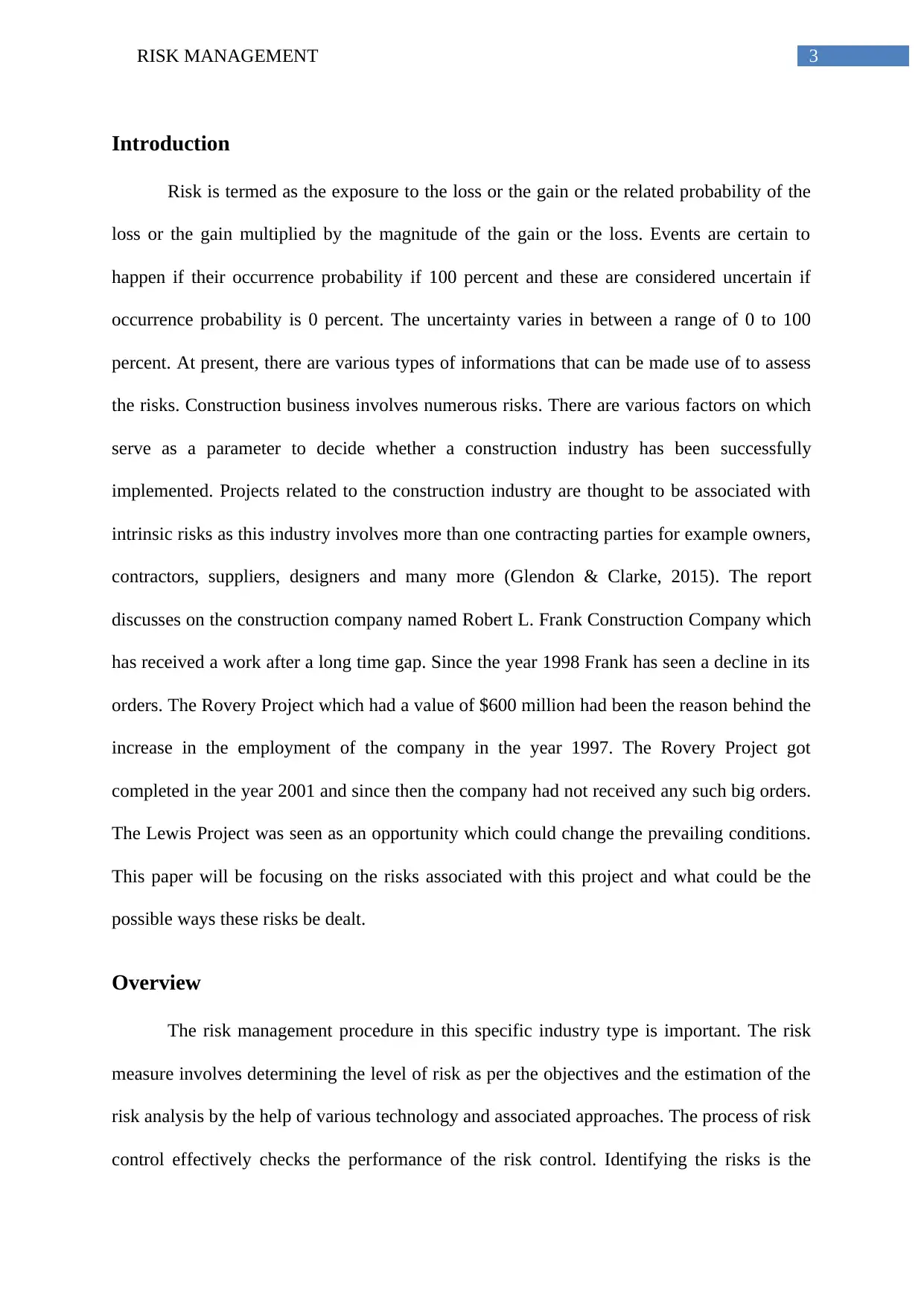
3RISK MANAGEMENT
Introduction
Risk is termed as the exposure to the loss or the gain or the related probability of the
loss or the gain multiplied by the magnitude of the gain or the loss. Events are certain to
happen if their occurrence probability if 100 percent and these are considered uncertain if
occurrence probability is 0 percent. The uncertainty varies in between a range of 0 to 100
percent. At present, there are various types of informations that can be made use of to assess
the risks. Construction business involves numerous risks. There are various factors on which
serve as a parameter to decide whether a construction industry has been successfully
implemented. Projects related to the construction industry are thought to be associated with
intrinsic risks as this industry involves more than one contracting parties for example owners,
contractors, suppliers, designers and many more (Glendon & Clarke, 2015). The report
discusses on the construction company named Robert L. Frank Construction Company which
has received a work after a long time gap. Since the year 1998 Frank has seen a decline in its
orders. The Rovery Project which had a value of $600 million had been the reason behind the
increase in the employment of the company in the year 1997. The Rovery Project got
completed in the year 2001 and since then the company had not received any such big orders.
The Lewis Project was seen as an opportunity which could change the prevailing conditions.
This paper will be focusing on the risks associated with this project and what could be the
possible ways these risks be dealt.
Overview
The risk management procedure in this specific industry type is important. The risk
measure involves determining the level of risk as per the objectives and the estimation of the
risk analysis by the help of various technology and associated approaches. The process of risk
control effectively checks the performance of the risk control. Identifying the risks is the
Introduction
Risk is termed as the exposure to the loss or the gain or the related probability of the
loss or the gain multiplied by the magnitude of the gain or the loss. Events are certain to
happen if their occurrence probability if 100 percent and these are considered uncertain if
occurrence probability is 0 percent. The uncertainty varies in between a range of 0 to 100
percent. At present, there are various types of informations that can be made use of to assess
the risks. Construction business involves numerous risks. There are various factors on which
serve as a parameter to decide whether a construction industry has been successfully
implemented. Projects related to the construction industry are thought to be associated with
intrinsic risks as this industry involves more than one contracting parties for example owners,
contractors, suppliers, designers and many more (Glendon & Clarke, 2015). The report
discusses on the construction company named Robert L. Frank Construction Company which
has received a work after a long time gap. Since the year 1998 Frank has seen a decline in its
orders. The Rovery Project which had a value of $600 million had been the reason behind the
increase in the employment of the company in the year 1997. The Rovery Project got
completed in the year 2001 and since then the company had not received any such big orders.
The Lewis Project was seen as an opportunity which could change the prevailing conditions.
This paper will be focusing on the risks associated with this project and what could be the
possible ways these risks be dealt.
Overview
The risk management procedure in this specific industry type is important. The risk
measure involves determining the level of risk as per the objectives and the estimation of the
risk analysis by the help of various technology and associated approaches. The process of risk
control effectively checks the performance of the risk control. Identifying the risks is the
Paraphrase This Document
Need a fresh take? Get an instant paraphrase of this document with our AI Paraphraser
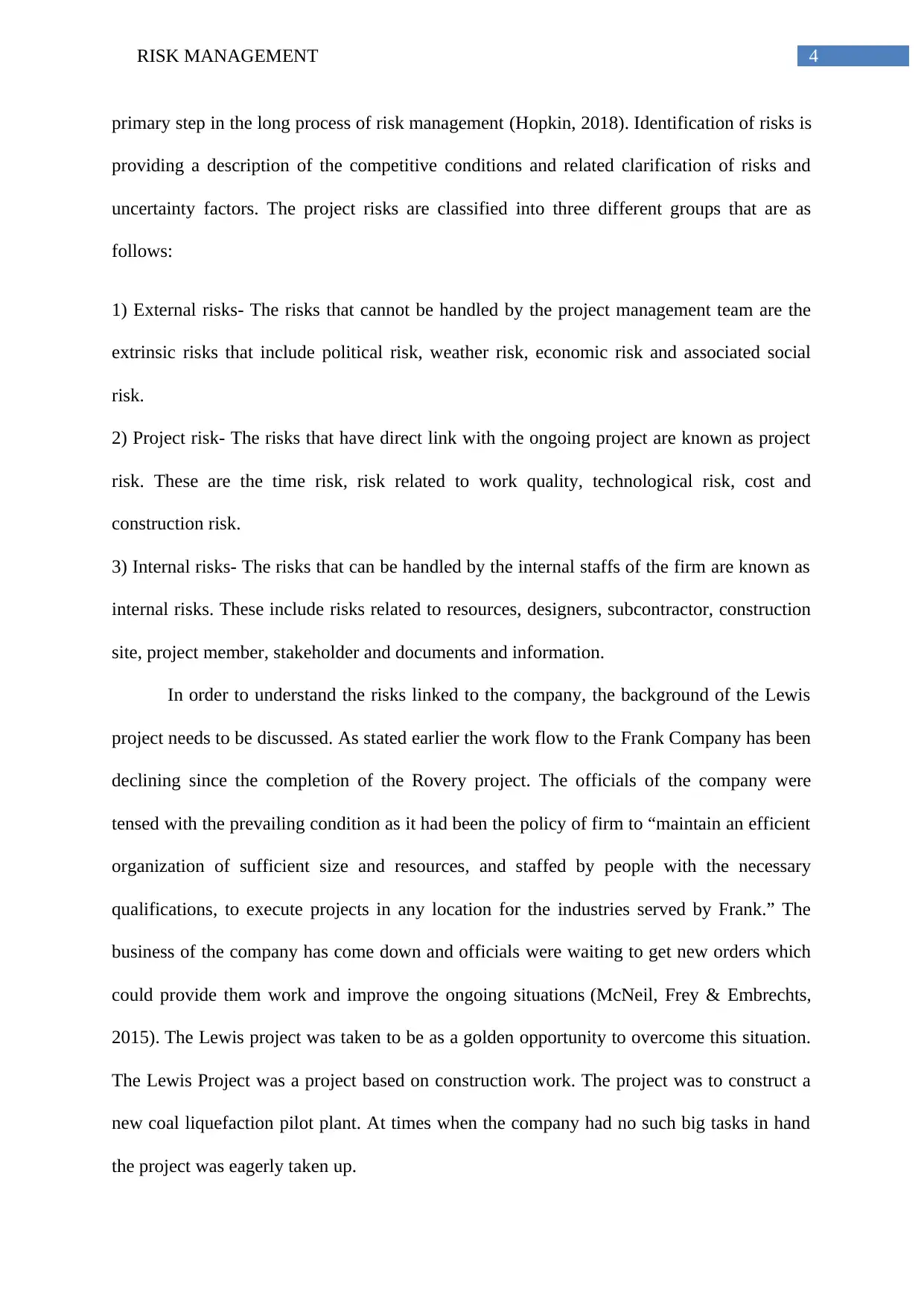
4RISK MANAGEMENT
primary step in the long process of risk management (Hopkin, 2018). Identification of risks is
providing a description of the competitive conditions and related clarification of risks and
uncertainty factors. The project risks are classified into three different groups that are as
follows:
1) External risks- The risks that cannot be handled by the project management team are the
extrinsic risks that include political risk, weather risk, economic risk and associated social
risk.
2) Project risk- The risks that have direct link with the ongoing project are known as project
risk. These are the time risk, risk related to work quality, technological risk, cost and
construction risk.
3) Internal risks- The risks that can be handled by the internal staffs of the firm are known as
internal risks. These include risks related to resources, designers, subcontractor, construction
site, project member, stakeholder and documents and information.
In order to understand the risks linked to the company, the background of the Lewis
project needs to be discussed. As stated earlier the work flow to the Frank Company has been
declining since the completion of the Rovery project. The officials of the company were
tensed with the prevailing condition as it had been the policy of firm to “maintain an efficient
organization of sufficient size and resources, and staffed by people with the necessary
qualifications, to execute projects in any location for the industries served by Frank.” The
business of the company has come down and officials were waiting to get new orders which
could provide them work and improve the ongoing situations (McNeil, Frey & Embrechts,
2015). The Lewis project was taken to be as a golden opportunity to overcome this situation.
The Lewis Project was a project based on construction work. The project was to construct a
new coal liquefaction pilot plant. At times when the company had no such big tasks in hand
the project was eagerly taken up.
primary step in the long process of risk management (Hopkin, 2018). Identification of risks is
providing a description of the competitive conditions and related clarification of risks and
uncertainty factors. The project risks are classified into three different groups that are as
follows:
1) External risks- The risks that cannot be handled by the project management team are the
extrinsic risks that include political risk, weather risk, economic risk and associated social
risk.
2) Project risk- The risks that have direct link with the ongoing project are known as project
risk. These are the time risk, risk related to work quality, technological risk, cost and
construction risk.
3) Internal risks- The risks that can be handled by the internal staffs of the firm are known as
internal risks. These include risks related to resources, designers, subcontractor, construction
site, project member, stakeholder and documents and information.
In order to understand the risks linked to the company, the background of the Lewis
project needs to be discussed. As stated earlier the work flow to the Frank Company has been
declining since the completion of the Rovery project. The officials of the company were
tensed with the prevailing condition as it had been the policy of firm to “maintain an efficient
organization of sufficient size and resources, and staffed by people with the necessary
qualifications, to execute projects in any location for the industries served by Frank.” The
business of the company has come down and officials were waiting to get new orders which
could provide them work and improve the ongoing situations (McNeil, Frey & Embrechts,
2015). The Lewis project was taken to be as a golden opportunity to overcome this situation.
The Lewis Project was a project based on construction work. The project was to construct a
new coal liquefaction pilot plant. At times when the company had no such big tasks in hand
the project was eagerly taken up.
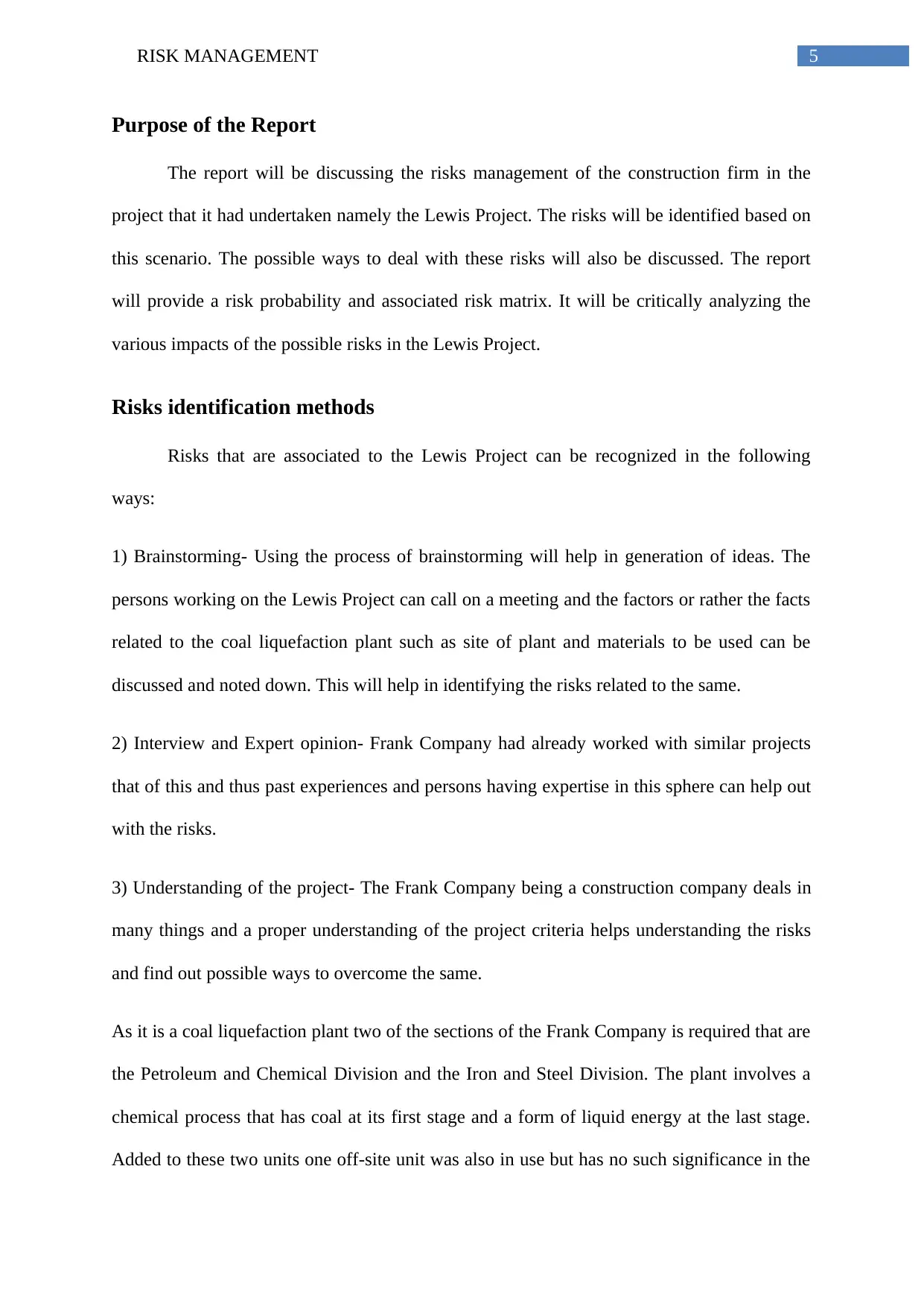
5RISK MANAGEMENT
Purpose of the Report
The report will be discussing the risks management of the construction firm in the
project that it had undertaken namely the Lewis Project. The risks will be identified based on
this scenario. The possible ways to deal with these risks will also be discussed. The report
will provide a risk probability and associated risk matrix. It will be critically analyzing the
various impacts of the possible risks in the Lewis Project.
Risks identification methods
Risks that are associated to the Lewis Project can be recognized in the following
ways:
1) Brainstorming- Using the process of brainstorming will help in generation of ideas. The
persons working on the Lewis Project can call on a meeting and the factors or rather the facts
related to the coal liquefaction plant such as site of plant and materials to be used can be
discussed and noted down. This will help in identifying the risks related to the same.
2) Interview and Expert opinion- Frank Company had already worked with similar projects
that of this and thus past experiences and persons having expertise in this sphere can help out
with the risks.
3) Understanding of the project- The Frank Company being a construction company deals in
many things and a proper understanding of the project criteria helps understanding the risks
and find out possible ways to overcome the same.
As it is a coal liquefaction plant two of the sections of the Frank Company is required that are
the Petroleum and Chemical Division and the Iron and Steel Division. The plant involves a
chemical process that has coal at its first stage and a form of liquid energy at the last stage.
Added to these two units one off-site unit was also in use but has no such significance in the
Purpose of the Report
The report will be discussing the risks management of the construction firm in the
project that it had undertaken namely the Lewis Project. The risks will be identified based on
this scenario. The possible ways to deal with these risks will also be discussed. The report
will provide a risk probability and associated risk matrix. It will be critically analyzing the
various impacts of the possible risks in the Lewis Project.
Risks identification methods
Risks that are associated to the Lewis Project can be recognized in the following
ways:
1) Brainstorming- Using the process of brainstorming will help in generation of ideas. The
persons working on the Lewis Project can call on a meeting and the factors or rather the facts
related to the coal liquefaction plant such as site of plant and materials to be used can be
discussed and noted down. This will help in identifying the risks related to the same.
2) Interview and Expert opinion- Frank Company had already worked with similar projects
that of this and thus past experiences and persons having expertise in this sphere can help out
with the risks.
3) Understanding of the project- The Frank Company being a construction company deals in
many things and a proper understanding of the project criteria helps understanding the risks
and find out possible ways to overcome the same.
As it is a coal liquefaction plant two of the sections of the Frank Company is required that are
the Petroleum and Chemical Division and the Iron and Steel Division. The plant involves a
chemical process that has coal at its first stage and a form of liquid energy at the last stage.
Added to these two units one off-site unit was also in use but has no such significance in the
⊘ This is a preview!⊘
Do you want full access?
Subscribe today to unlock all pages.

Trusted by 1+ million students worldwide
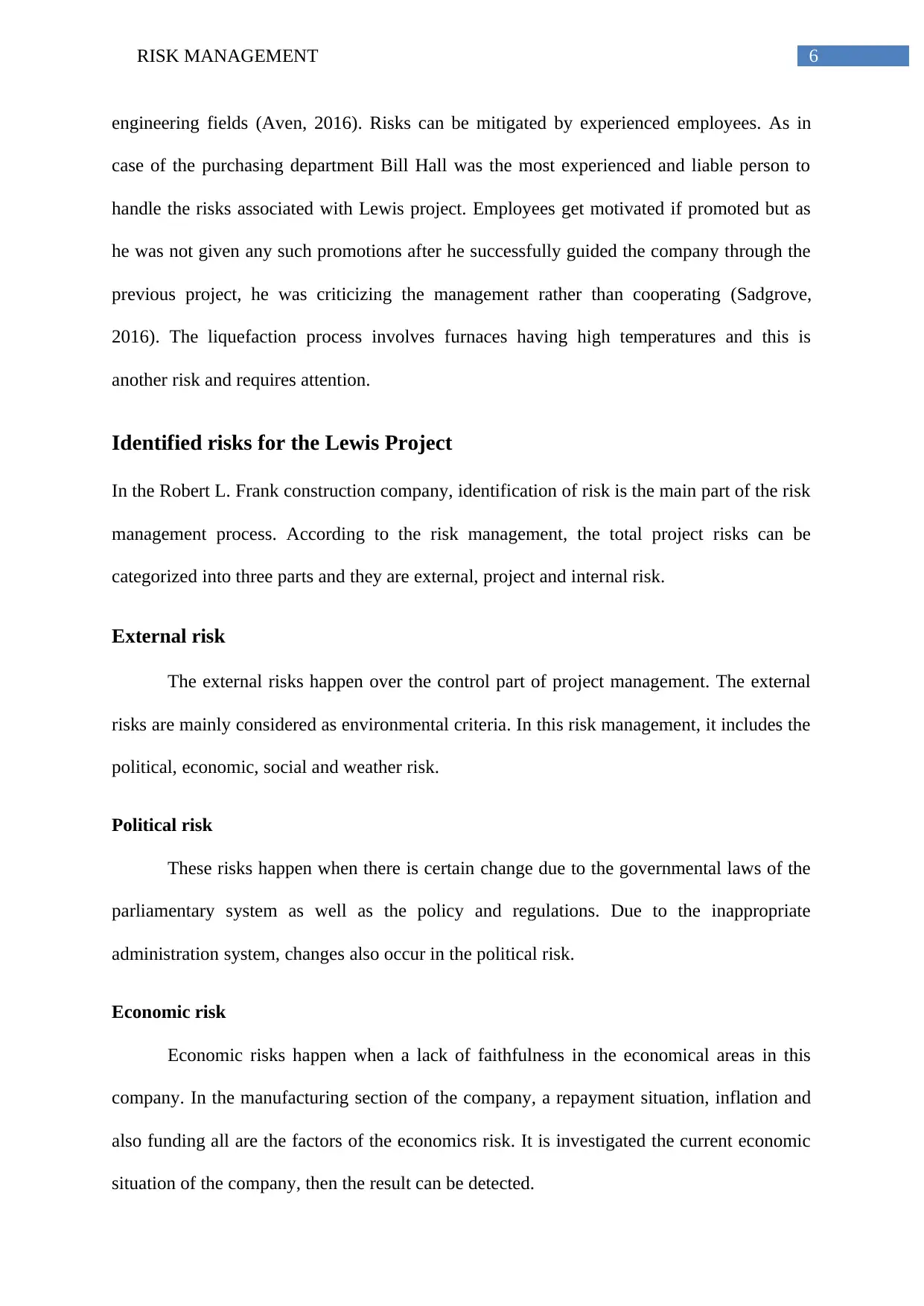
6RISK MANAGEMENT
engineering fields (Aven, 2016). Risks can be mitigated by experienced employees. As in
case of the purchasing department Bill Hall was the most experienced and liable person to
handle the risks associated with Lewis project. Employees get motivated if promoted but as
he was not given any such promotions after he successfully guided the company through the
previous project, he was criticizing the management rather than cooperating (Sadgrove,
2016). The liquefaction process involves furnaces having high temperatures and this is
another risk and requires attention.
Identified risks for the Lewis Project
In the Robert L. Frank construction company, identification of risk is the main part of the risk
management process. According to the risk management, the total project risks can be
categorized into three parts and they are external, project and internal risk.
External risk
The external risks happen over the control part of project management. The external
risks are mainly considered as environmental criteria. In this risk management, it includes the
political, economic, social and weather risk.
Political risk
These risks happen when there is certain change due to the governmental laws of the
parliamentary system as well as the policy and regulations. Due to the inappropriate
administration system, changes also occur in the political risk.
Economic risk
Economic risks happen when a lack of faithfulness in the economical areas in this
company. In the manufacturing section of the company, a repayment situation, inflation and
also funding all are the factors of the economics risk. It is investigated the current economic
situation of the company, then the result can be detected.
engineering fields (Aven, 2016). Risks can be mitigated by experienced employees. As in
case of the purchasing department Bill Hall was the most experienced and liable person to
handle the risks associated with Lewis project. Employees get motivated if promoted but as
he was not given any such promotions after he successfully guided the company through the
previous project, he was criticizing the management rather than cooperating (Sadgrove,
2016). The liquefaction process involves furnaces having high temperatures and this is
another risk and requires attention.
Identified risks for the Lewis Project
In the Robert L. Frank construction company, identification of risk is the main part of the risk
management process. According to the risk management, the total project risks can be
categorized into three parts and they are external, project and internal risk.
External risk
The external risks happen over the control part of project management. The external
risks are mainly considered as environmental criteria. In this risk management, it includes the
political, economic, social and weather risk.
Political risk
These risks happen when there is certain change due to the governmental laws of the
parliamentary system as well as the policy and regulations. Due to the inappropriate
administration system, changes also occur in the political risk.
Economic risk
Economic risks happen when a lack of faithfulness in the economical areas in this
company. In the manufacturing section of the company, a repayment situation, inflation and
also funding all are the factors of the economics risk. It is investigated the current economic
situation of the company, then the result can be detected.
Paraphrase This Document
Need a fresh take? Get an instant paraphrase of this document with our AI Paraphraser
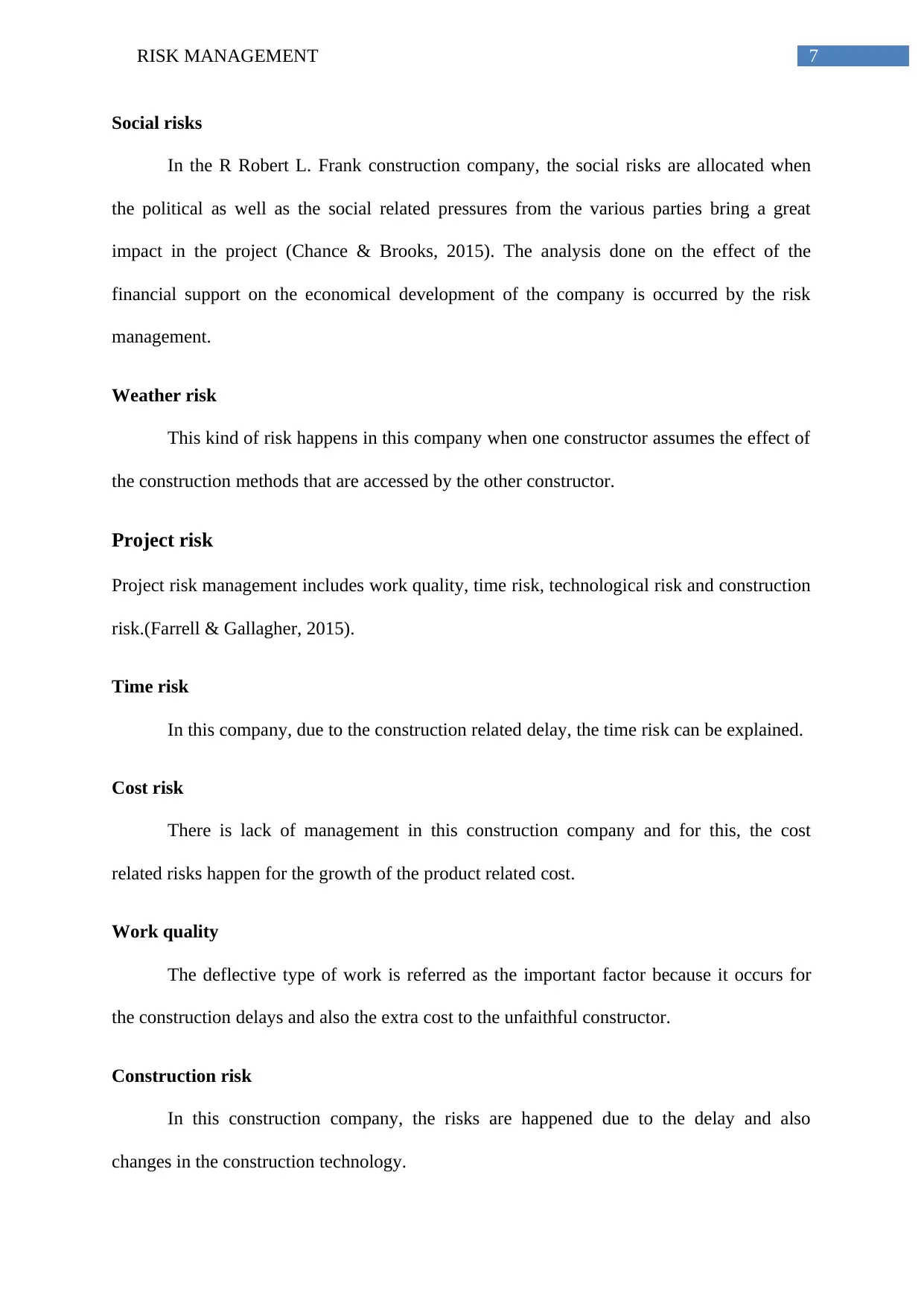
7RISK MANAGEMENT
Social risks
In the R Robert L. Frank construction company, the social risks are allocated when
the political as well as the social related pressures from the various parties bring a great
impact in the project (Chance & Brooks, 2015). The analysis done on the effect of the
financial support on the economical development of the company is occurred by the risk
management.
Weather risk
This kind of risk happens in this company when one constructor assumes the effect of
the construction methods that are accessed by the other constructor.
Project risk
Project risk management includes work quality, time risk, technological risk and construction
risk.(Farrell & Gallagher, 2015).
Time risk
In this company, due to the construction related delay, the time risk can be explained.
Cost risk
There is lack of management in this construction company and for this, the cost
related risks happen for the growth of the product related cost.
Work quality
The deflective type of work is referred as the important factor because it occurs for
the construction delays and also the extra cost to the unfaithful constructor.
Construction risk
In this construction company, the risks are happened due to the delay and also
changes in the construction technology.
Social risks
In the R Robert L. Frank construction company, the social risks are allocated when
the political as well as the social related pressures from the various parties bring a great
impact in the project (Chance & Brooks, 2015). The analysis done on the effect of the
financial support on the economical development of the company is occurred by the risk
management.
Weather risk
This kind of risk happens in this company when one constructor assumes the effect of
the construction methods that are accessed by the other constructor.
Project risk
Project risk management includes work quality, time risk, technological risk and construction
risk.(Farrell & Gallagher, 2015).
Time risk
In this company, due to the construction related delay, the time risk can be explained.
Cost risk
There is lack of management in this construction company and for this, the cost
related risks happen for the growth of the product related cost.
Work quality
The deflective type of work is referred as the important factor because it occurs for
the construction delays and also the extra cost to the unfaithful constructor.
Construction risk
In this construction company, the risks are happened due to the delay and also
changes in the construction technology.
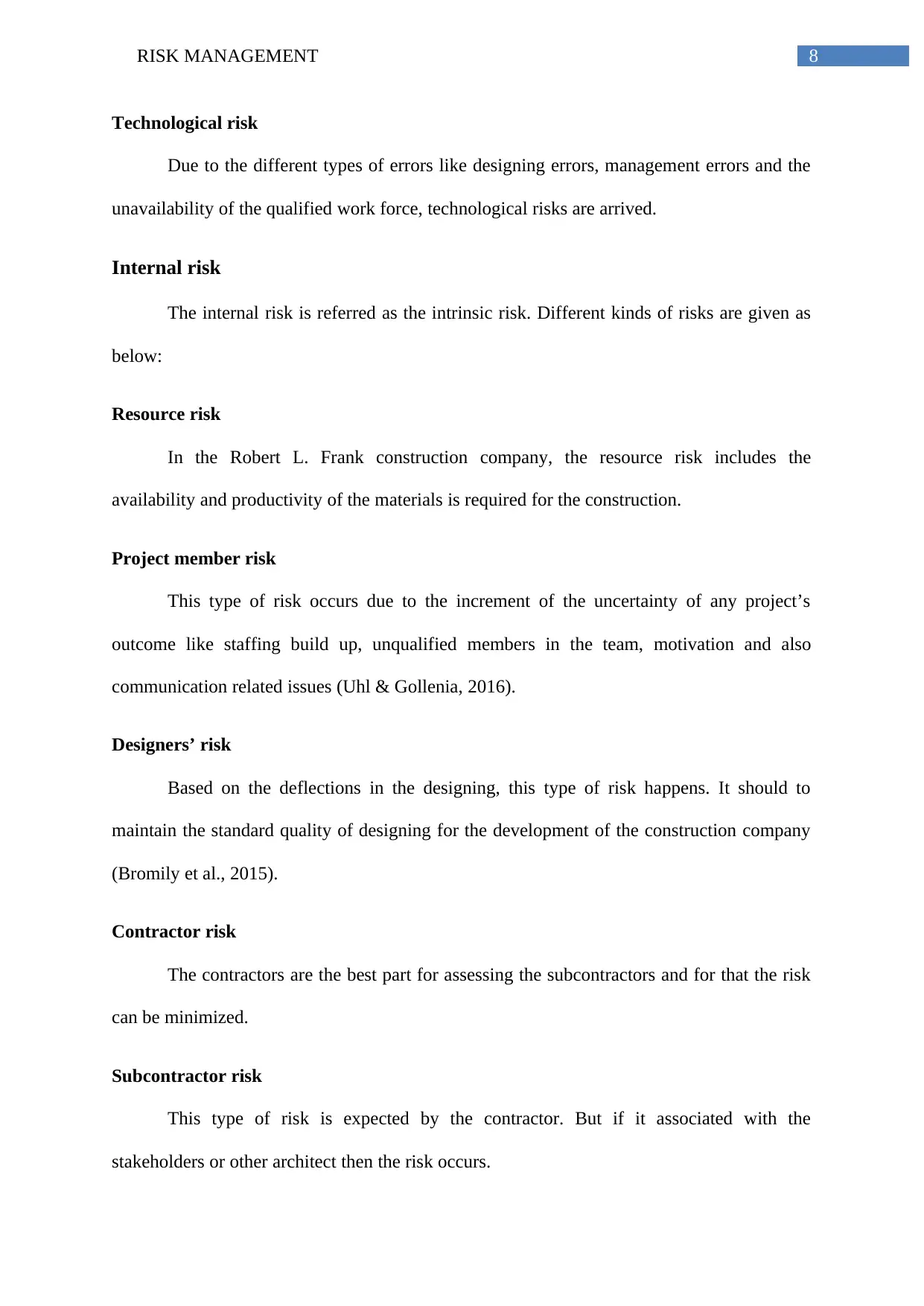
8RISK MANAGEMENT
Technological risk
Due to the different types of errors like designing errors, management errors and the
unavailability of the qualified work force, technological risks are arrived.
Internal risk
The internal risk is referred as the intrinsic risk. Different kinds of risks are given as
below:
Resource risk
In the Robert L. Frank construction company, the resource risk includes the
availability and productivity of the materials is required for the construction.
Project member risk
This type of risk occurs due to the increment of the uncertainty of any project’s
outcome like staffing build up, unqualified members in the team, motivation and also
communication related issues (Uhl & Gollenia, 2016).
Designers’ risk
Based on the deflections in the designing, this type of risk happens. It should to
maintain the standard quality of designing for the development of the construction company
(Bromily et al., 2015).
Contractor risk
The contractors are the best part for assessing the subcontractors and for that the risk
can be minimized.
Subcontractor risk
This type of risk is expected by the contractor. But if it associated with the
stakeholders or other architect then the risk occurs.
Technological risk
Due to the different types of errors like designing errors, management errors and the
unavailability of the qualified work force, technological risks are arrived.
Internal risk
The internal risk is referred as the intrinsic risk. Different kinds of risks are given as
below:
Resource risk
In the Robert L. Frank construction company, the resource risk includes the
availability and productivity of the materials is required for the construction.
Project member risk
This type of risk occurs due to the increment of the uncertainty of any project’s
outcome like staffing build up, unqualified members in the team, motivation and also
communication related issues (Uhl & Gollenia, 2016).
Designers’ risk
Based on the deflections in the designing, this type of risk happens. It should to
maintain the standard quality of designing for the development of the construction company
(Bromily et al., 2015).
Contractor risk
The contractors are the best part for assessing the subcontractors and for that the risk
can be minimized.
Subcontractor risk
This type of risk is expected by the contractor. But if it associated with the
stakeholders or other architect then the risk occurs.
⊘ This is a preview!⊘
Do you want full access?
Subscribe today to unlock all pages.

Trusted by 1+ million students worldwide
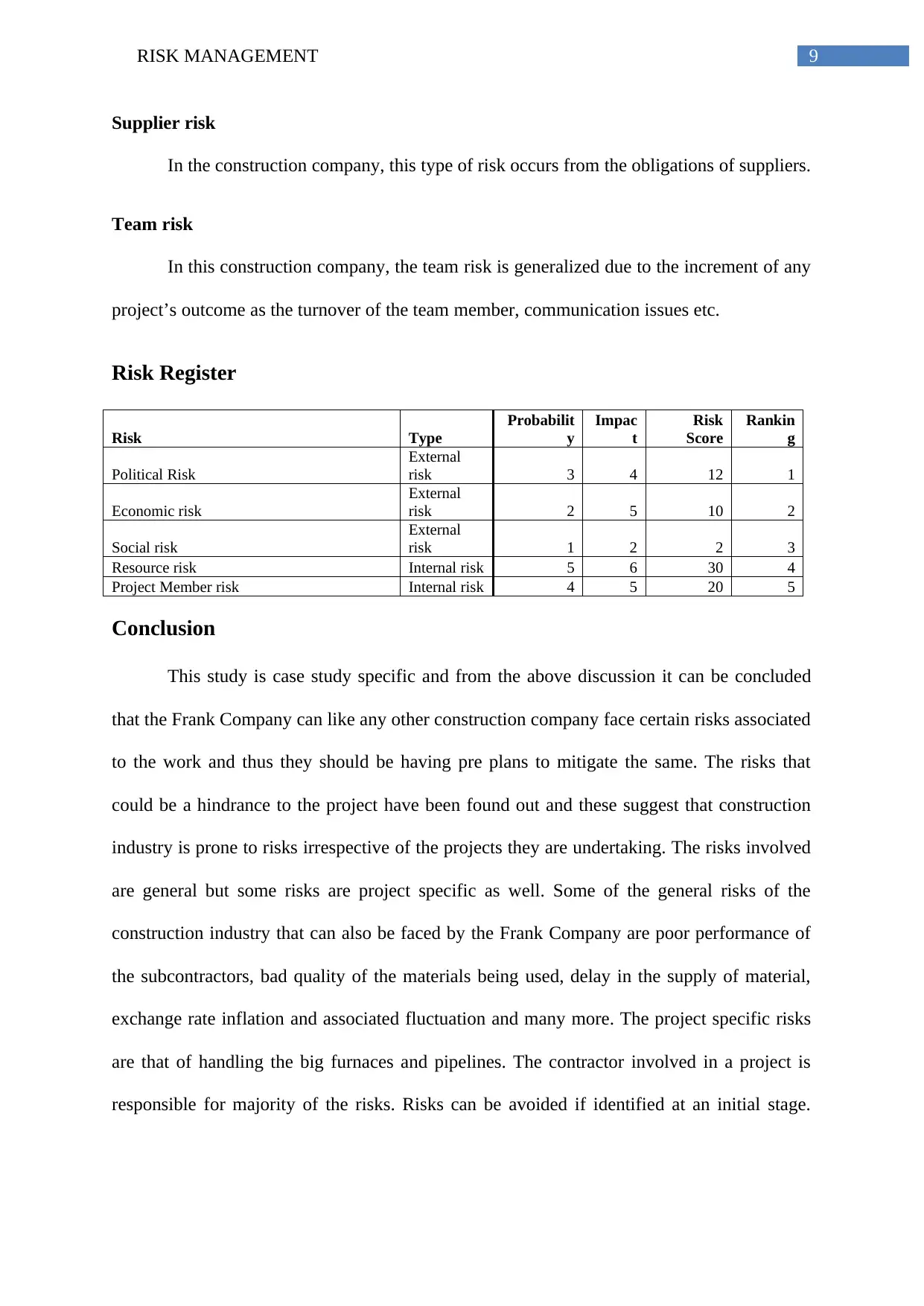
9RISK MANAGEMENT
Supplier risk
In the construction company, this type of risk occurs from the obligations of suppliers.
Team risk
In this construction company, the team risk is generalized due to the increment of any
project’s outcome as the turnover of the team member, communication issues etc.
Risk Register
Risk Type
Probabilit
y
Impac
t
Risk
Score
Rankin
g
Political Risk
External
risk 3 4 12 1
Economic risk
External
risk 2 5 10 2
Social risk
External
risk 1 2 2 3
Resource risk Internal risk 5 6 30 4
Project Member risk Internal risk 4 5 20 5
Conclusion
This study is case study specific and from the above discussion it can be concluded
that the Frank Company can like any other construction company face certain risks associated
to the work and thus they should be having pre plans to mitigate the same. The risks that
could be a hindrance to the project have been found out and these suggest that construction
industry is prone to risks irrespective of the projects they are undertaking. The risks involved
are general but some risks are project specific as well. Some of the general risks of the
construction industry that can also be faced by the Frank Company are poor performance of
the subcontractors, bad quality of the materials being used, delay in the supply of material,
exchange rate inflation and associated fluctuation and many more. The project specific risks
are that of handling the big furnaces and pipelines. The contractor involved in a project is
responsible for majority of the risks. Risks can be avoided if identified at an initial stage.
Supplier risk
In the construction company, this type of risk occurs from the obligations of suppliers.
Team risk
In this construction company, the team risk is generalized due to the increment of any
project’s outcome as the turnover of the team member, communication issues etc.
Risk Register
Risk Type
Probabilit
y
Impac
t
Risk
Score
Rankin
g
Political Risk
External
risk 3 4 12 1
Economic risk
External
risk 2 5 10 2
Social risk
External
risk 1 2 2 3
Resource risk Internal risk 5 6 30 4
Project Member risk Internal risk 4 5 20 5
Conclusion
This study is case study specific and from the above discussion it can be concluded
that the Frank Company can like any other construction company face certain risks associated
to the work and thus they should be having pre plans to mitigate the same. The risks that
could be a hindrance to the project have been found out and these suggest that construction
industry is prone to risks irrespective of the projects they are undertaking. The risks involved
are general but some risks are project specific as well. Some of the general risks of the
construction industry that can also be faced by the Frank Company are poor performance of
the subcontractors, bad quality of the materials being used, delay in the supply of material,
exchange rate inflation and associated fluctuation and many more. The project specific risks
are that of handling the big furnaces and pipelines. The contractor involved in a project is
responsible for majority of the risks. Risks can be avoided if identified at an initial stage.
Paraphrase This Document
Need a fresh take? Get an instant paraphrase of this document with our AI Paraphraser
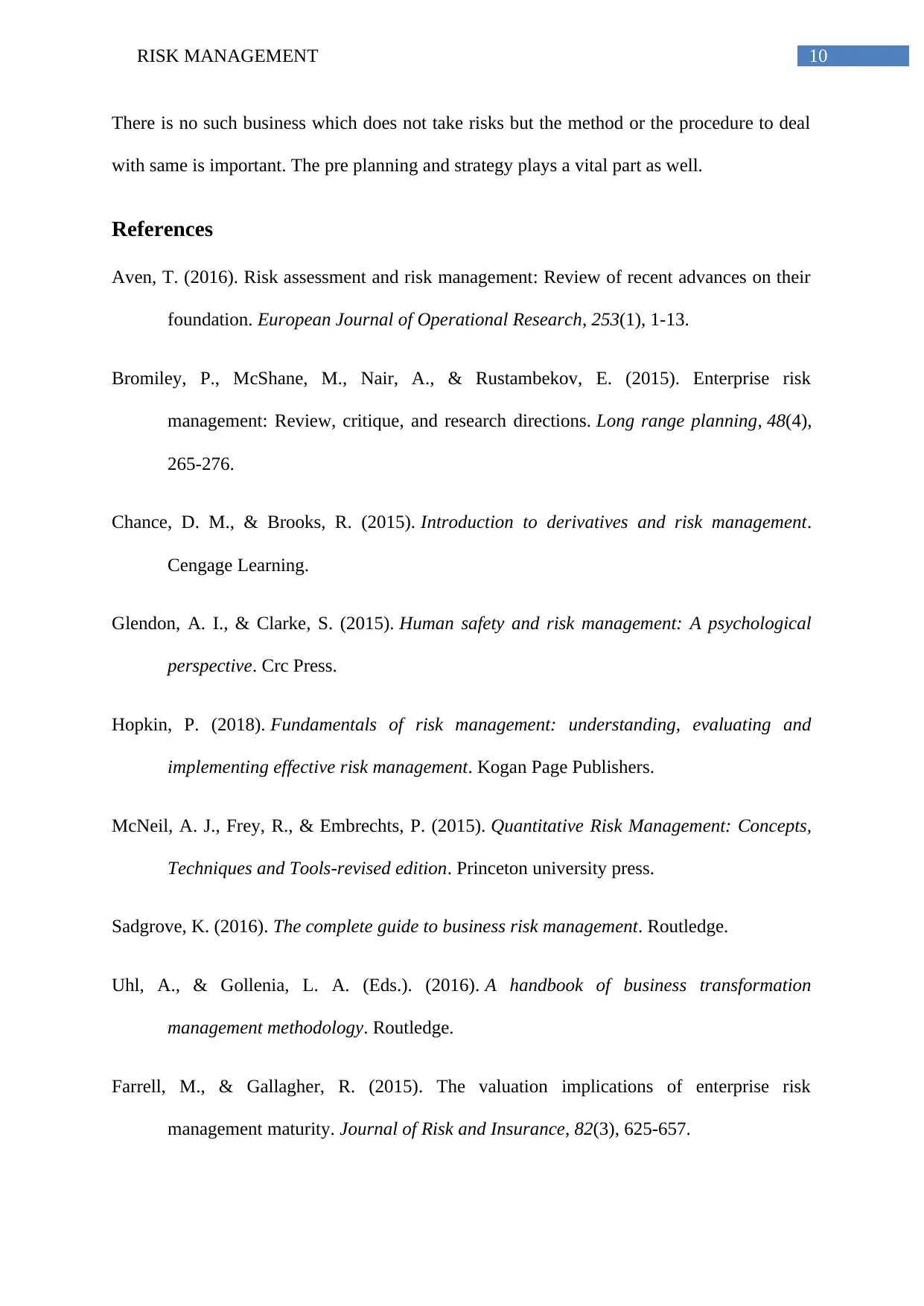
10RISK MANAGEMENT
There is no such business which does not take risks but the method or the procedure to deal
with same is important. The pre planning and strategy plays a vital part as well.
References
Aven, T. (2016). Risk assessment and risk management: Review of recent advances on their
foundation. European Journal of Operational Research, 253(1), 1-13.
Bromiley, P., McShane, M., Nair, A., & Rustambekov, E. (2015). Enterprise risk
management: Review, critique, and research directions. Long range planning, 48(4),
265-276.
Chance, D. M., & Brooks, R. (2015). Introduction to derivatives and risk management.
Cengage Learning.
Glendon, A. I., & Clarke, S. (2015). Human safety and risk management: A psychological
perspective. Crc Press.
Hopkin, P. (2018). Fundamentals of risk management: understanding, evaluating and
implementing effective risk management. Kogan Page Publishers.
McNeil, A. J., Frey, R., & Embrechts, P. (2015). Quantitative Risk Management: Concepts,
Techniques and Tools-revised edition. Princeton university press.
Sadgrove, K. (2016). The complete guide to business risk management. Routledge.
Uhl, A., & Gollenia, L. A. (Eds.). (2016). A handbook of business transformation
management methodology. Routledge.
Farrell, M., & Gallagher, R. (2015). The valuation implications of enterprise risk
management maturity. Journal of Risk and Insurance, 82(3), 625-657.
There is no such business which does not take risks but the method or the procedure to deal
with same is important. The pre planning and strategy plays a vital part as well.
References
Aven, T. (2016). Risk assessment and risk management: Review of recent advances on their
foundation. European Journal of Operational Research, 253(1), 1-13.
Bromiley, P., McShane, M., Nair, A., & Rustambekov, E. (2015). Enterprise risk
management: Review, critique, and research directions. Long range planning, 48(4),
265-276.
Chance, D. M., & Brooks, R. (2015). Introduction to derivatives and risk management.
Cengage Learning.
Glendon, A. I., & Clarke, S. (2015). Human safety and risk management: A psychological
perspective. Crc Press.
Hopkin, P. (2018). Fundamentals of risk management: understanding, evaluating and
implementing effective risk management. Kogan Page Publishers.
McNeil, A. J., Frey, R., & Embrechts, P. (2015). Quantitative Risk Management: Concepts,
Techniques and Tools-revised edition. Princeton university press.
Sadgrove, K. (2016). The complete guide to business risk management. Routledge.
Uhl, A., & Gollenia, L. A. (Eds.). (2016). A handbook of business transformation
management methodology. Routledge.
Farrell, M., & Gallagher, R. (2015). The valuation implications of enterprise risk
management maturity. Journal of Risk and Insurance, 82(3), 625-657.
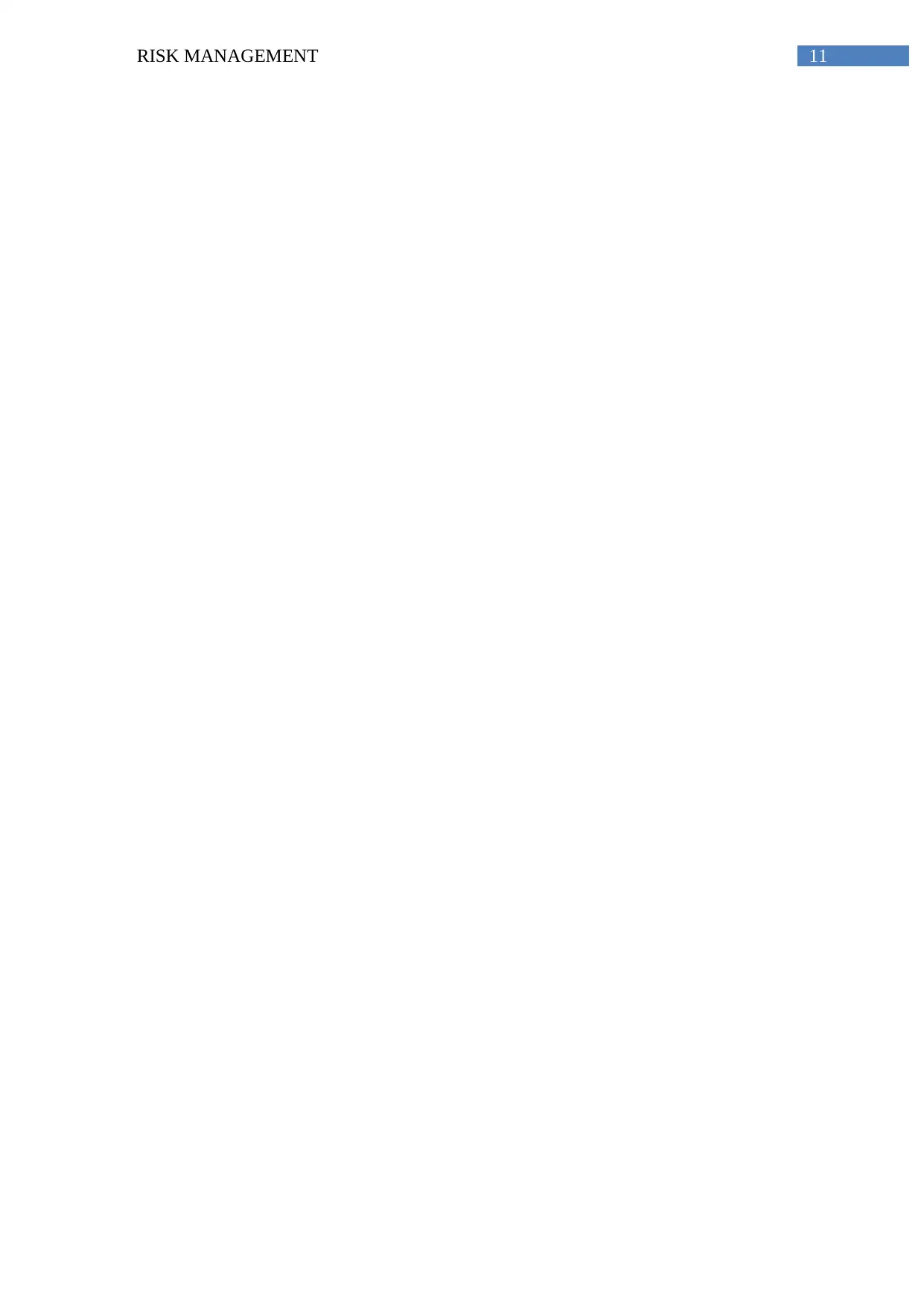
11RISK MANAGEMENT
⊘ This is a preview!⊘
Do you want full access?
Subscribe today to unlock all pages.

Trusted by 1+ million students worldwide
1 out of 13
Related Documents
Your All-in-One AI-Powered Toolkit for Academic Success.
+13062052269
info@desklib.com
Available 24*7 on WhatsApp / Email
![[object Object]](/_next/static/media/star-bottom.7253800d.svg)
Unlock your academic potential
Copyright © 2020–2025 A2Z Services. All Rights Reserved. Developed and managed by ZUCOL.



